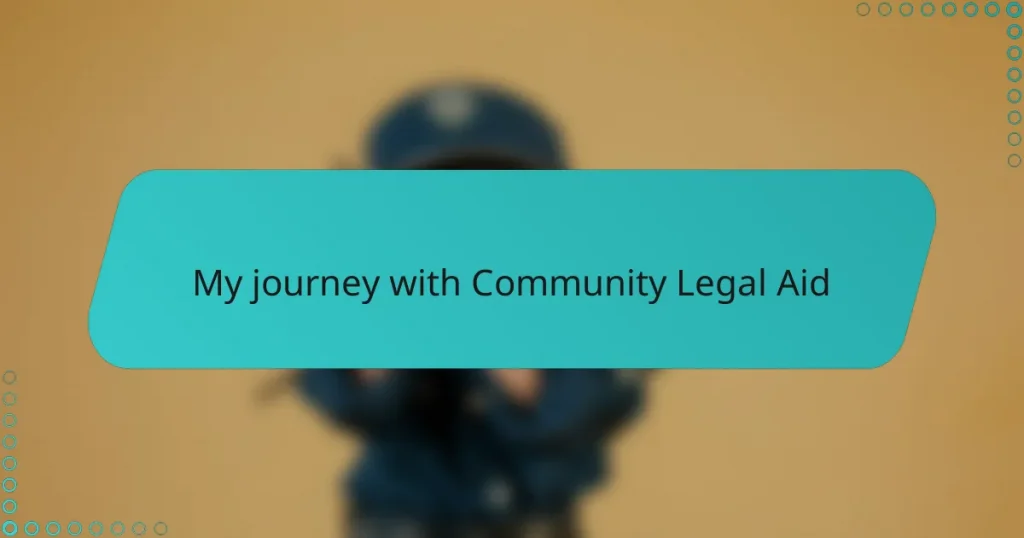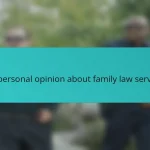Key takeaways
- Legal advocacy empowers individuals by providing clarity and support in navigating complex legal systems, fostering their confidence in understanding their rights.
- Community legal aid services offer crucial assistance beyond court representation, helping individuals with various issues and restoring hope in challenging situations.
- Advocates play essential roles as interpreters of the law, protectors against exploitation, and guides through legal procedures, combining empathy with strategic persistence.
- Success stories highlight the transformative impact of legal advocacy, demonstrating that victories are not only legal wins but also personal recoveries of dignity and hope.

Understanding Legal Advocacy Fundamentals
When I first encountered legal advocacy, I saw it as simply fighting for justice in court. But I soon realized it’s much more—it’s about empowering individuals who often feel powerless. Have you ever wondered why some people struggle to be heard despite having valid rights? That question struck me deeply as I listened to clients’ stories.
Legal advocacy, at its core, involves standing alongside people navigating complex legal systems. It’s not just about winning cases but ensuring fair treatment and access to justice. From my experience, the most powerful part is seeing someone regain confidence when they understand their rights clearly.
What surprised me the most was how legal advocacy blends empathy with knowledge. It requires patience and careful listening because every person’s situation is unique. I’ve learned that true advocacy means walking this journey together, not rushing to the outcome.
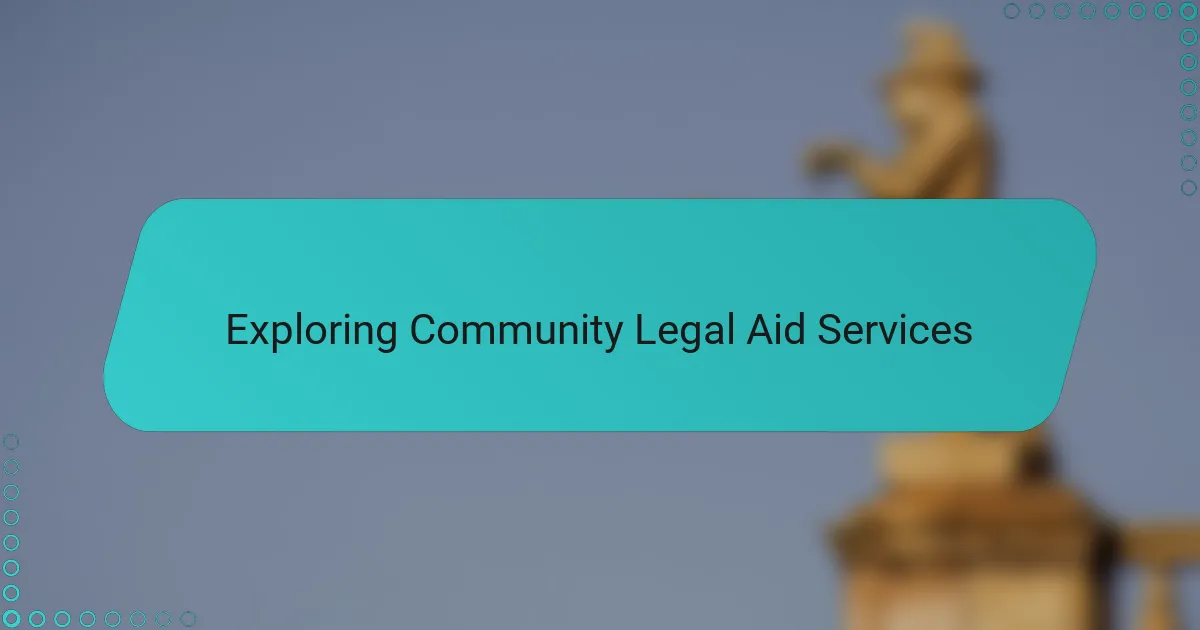
Exploring Community Legal Aid Services
Exploring Community Legal Aid Services opened my eyes to a world where legal help isn’t reserved for those who can afford it. Have you ever thought about how many people quietly struggle because legal advice feels out of reach? I remember meeting a client who believed justice was only a distant dream—then seeing their relief when a community legal aid worker explained their rights simply and clearly.
What struck me most was the range of support these services offer, far beyond courtroom battles. From helping someone fill out paperwork to providing guidance on housing or benefits issues, community legal aid meets people where they are. Experiencing this firsthand made me appreciate how these services bridge the gap between confusion and clarity.
At times, I felt humbled by the resilience I saw in the people relying on these services. Their courage to seek help, often in moments of great vulnerability, reminded me why community legal aid is so essential. It’s more than legal advice—it’s a lifeline that restores hope in seemingly hopeless situations.
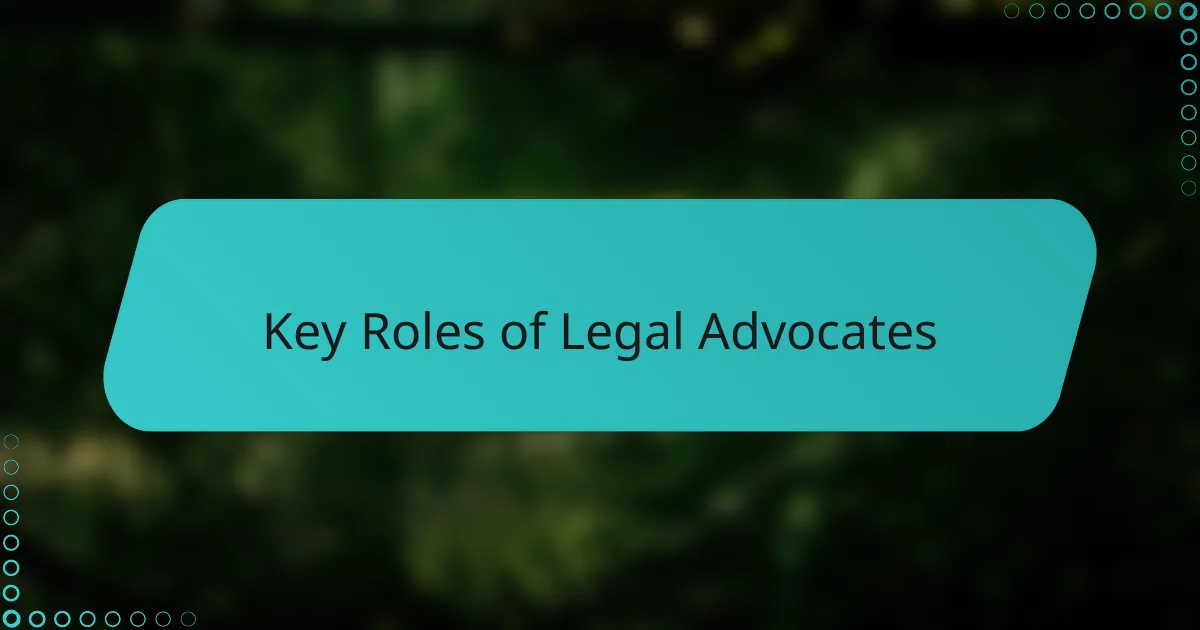
Key Roles of Legal Advocates
Legal advocates wear many hats, but one that stood out to me was their role as interpreters of the law. Have you ever felt lost in legal jargon that sounds more like a foreign language? I’ve seen advocates patiently break down complex terms into everyday language, making the law accessible and less intimidating.
Another crucial role is that of a protector. I recall a moment when an advocate stood firmly between a vulnerable client and an unjust process, shielding them from exploitation. Their presence wasn’t just legal—it was deeply human, offering safety and reassurance when it was needed most.
Advocates also serve as guides through the maze of legal procedures. It amazed me how they navigate deadlines, paperwork, and negotiations with calm precision. Watching this made me realize advocacy is as much about strategy and persistence as it is about compassion.
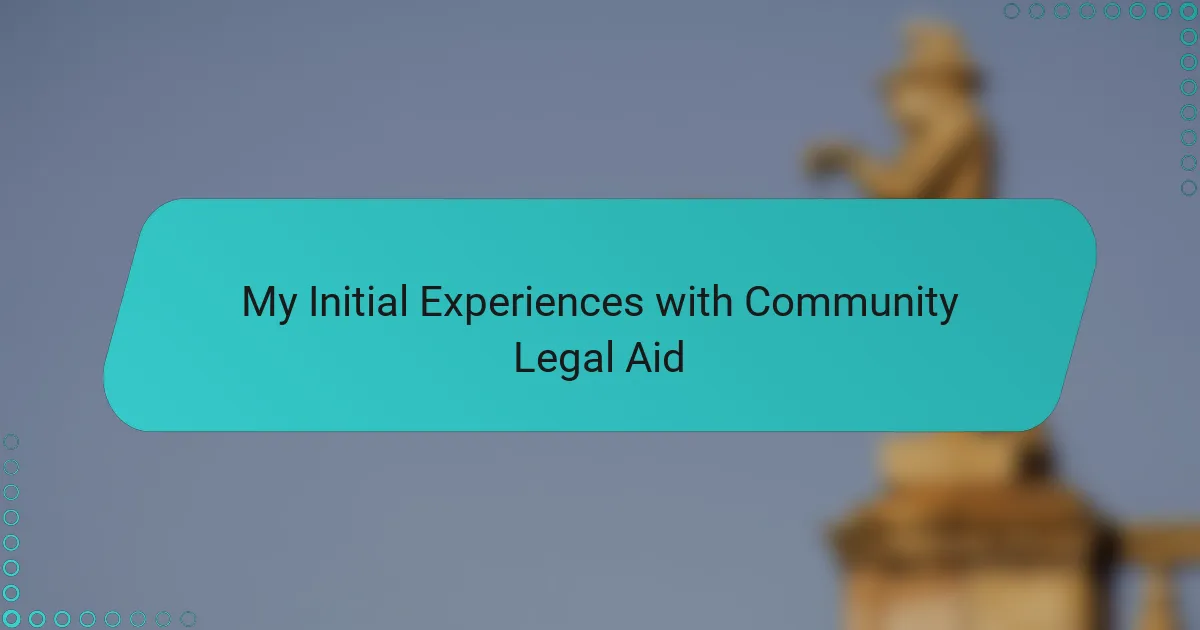
My Initial Experiences with Community Legal Aid
My first encounter with Community Legal Aid left a profound impression on me. I vividly recall sitting in a small office, listening as a client shared their story of feeling overwhelmed and isolated by a legal issue they thought they had no hope of resolving. That moment made me realize how crucial it is to have a place where people can find not only legal knowledge but genuine understanding.
Have you ever wondered what it feels like to watch someone’s anxiety transform into relief simply because they’ve been given clear, compassionate guidance? I’ve witnessed this transformation more than once, and it never ceases to move me. It showed me that the impact of legal aid is immediate and deeply personal, far beyond what any court verdict might convey.
What struck me too was how approachable and patient the community legal aid workers were. They didn’t rush or overwhelm clients with information; instead, they took the time to listen and explain things in a way that made sense. From that experience, I understood that effective legal help is as much about human connection as it is about legal expertise.
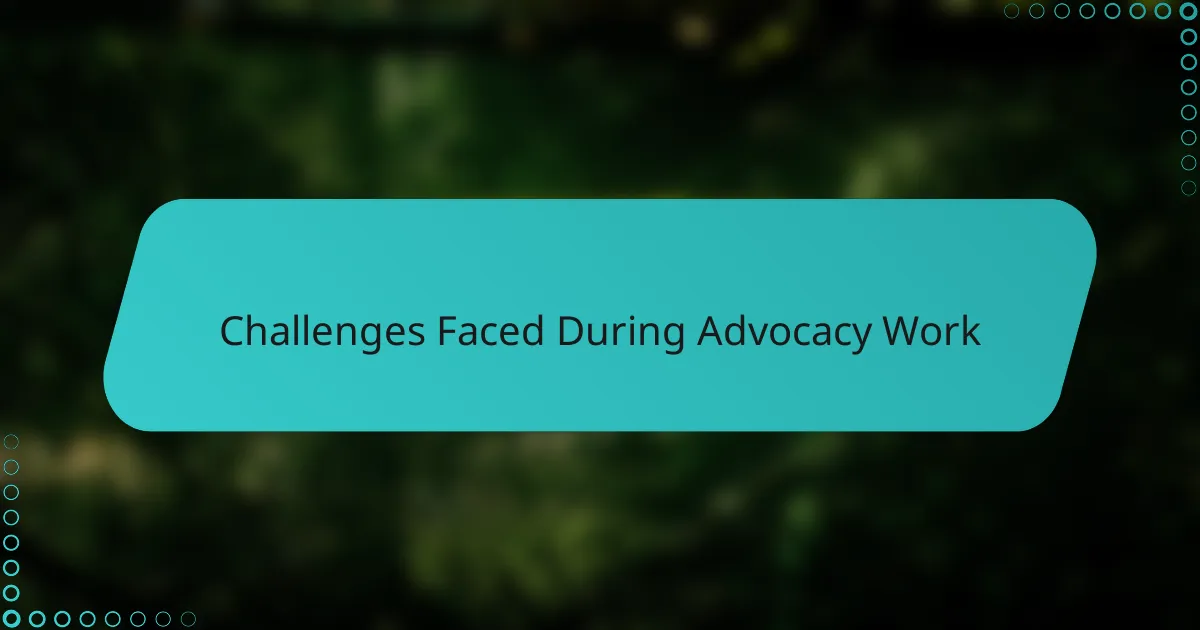
Challenges Faced During Advocacy Work
Working in advocacy, I quickly realized that one of the biggest hurdles is managing limited resources. Have you ever tried to help someone with a complex legal issue but felt there weren’t enough hours in the day? I faced that frustration often, knowing how much support each client needed while battling time and staffing constraints.
Another challenge I encountered was confronting systemic barriers that seem almost impossible to change. It’s disheartening when repeated efforts to seek justice meet long delays or bureaucratic roadblocks. I remember feeling the weight of these institutional obstacles firsthand, wondering how to keep hope alive for clients caught in these tangled processes.
Communication also posed its own unique difficulties. Sometimes, clients came burdened with fear or mistrust after years of negative experiences with the legal system. I learned that advocating effectively meant first breaking down those walls with patience and empathy—a lesson that transformed how I connect with the people I aim to support.
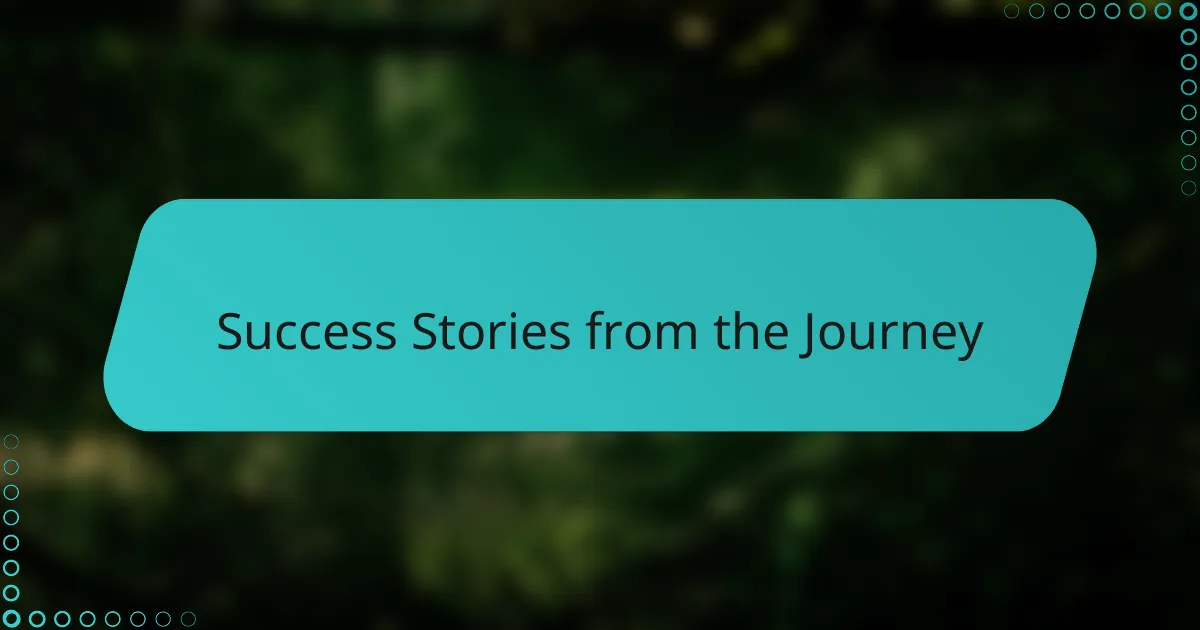
Success Stories from the Journey
Success stories became the heartbeat of my journey with Community Legal Aid. I recall one client, a single mother facing eviction, who walked in overwhelmed and defeated. Witnessing her regain hope after we secured her a fair hearing felt like reclaiming a small but profound victory—not just legally, but in her life’s narrative.
Have you ever seen justice serve as a turning point for someone? I have, many times. Another memorable moment was helping a young immigrant navigate an intimidating immigration process. When she smiled with the relief of understanding her rights and options, I realized success isn’t only about winning cases; it’s about restoring confidence and dignity.
These stories aren’t just wins on paper—they are powerful reminders of why this work matters. Every success is a testament to resilience and the difference that accessible legal advocacy can make, even when the odds seem stacked against clients. It keeps me motivated, knowing that our efforts transform lives in ways beyond the courtroom.

Practical Tips for Legal Advocacy Participation
One thing I’ve learned is the importance of preparation before diving into advocacy work. Have you ever gone into a meeting feeling unprepared and noticed how that unsettles your confidence? Taking the time to research the client’s issue and knowing the relevant laws not only steadies your own nerves but also shows respect for the person you’re helping.
Another tip I found invaluable is practicing clear communication. Legal matters can be overwhelming, so simplifying complex terms into everyday language makes a huge difference. I remember a moment when a client’s eyes lit up because suddenly, the confusing legal jargon became understandable—and that clarity empowered them in ways I hadn’t anticipated.
Lastly, don’t underestimate the power of persistence. Navigating bureaucratic hurdles often feels like running into brick walls. Yet, staying patient and consistent—even when progress seems slow—can lead to breakthroughs. From my experience, small, steady steps often pave the way for meaningful change in legal advocacy.
